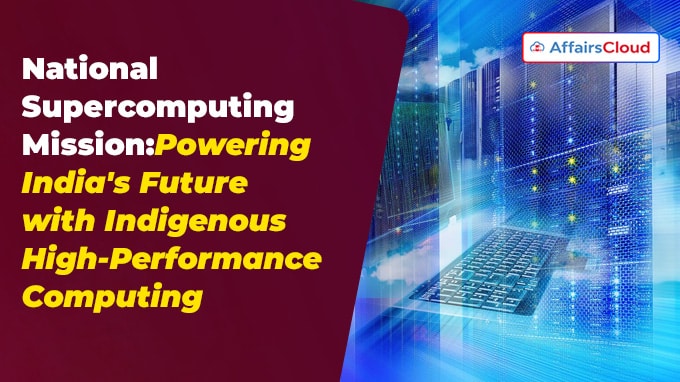 On 28 April 2025, the Ministry of Electronics and Information Technology (MeitY) announced that a total of 34 supercomputers with a combined computing power of 35 Petaflops (10 lakh gigabytes, gb) have been deployed across India under the National Supercomputing Mission (NSM).
On 28 April 2025, the Ministry of Electronics and Information Technology (MeitY) announced that a total of 34 supercomputers with a combined computing power of 35 Petaflops (10 lakh gigabytes, gb) have been deployed across India under the National Supercomputing Mission (NSM).
- NSM has opened new doors for researchers in smaller cities by giving them access to world-class supercomputing facilities.
Key Points:
i.These 34 supercomputers have been set up at top academic and research institutions such as Indian Institute of science (IISc), Institute of Information Technology (IITs), C-DAC, and also in several institutions from Tier-II and Tier-III cities.
ii.They are being used extensively, with more than 85% of their capacity in use—some even exceeding 95%, showing how efficiently they are performing.
iii.Over 10,000 researchers have used these systems, completing 1 crore tasks and publishing more than 1,500 papers in key scientific fields. Start-ups and MSMEs are also using these facilities to drive innovation in their projects.
About National Supercomputing Mission (NSM):
i.NSM was launched in 2015 by the Government of India (GoI) with the aim of making the country strong in the field of supercomputing. Through this mission, India plans to develop high-performance computing (HPC) systems.
- It is jointly steered by the Department of Science and Technology (DST) and MeitY. The mission is implemented by the Centre for Development of Advanced Computing (C-DAC), Pune, and the Indian Institute of Science (IISc), Bengaluru(Karnataka).
ii.Under NSM, supercomputers are being installed at educational and research institutions across India. These systems are not just powerful but are also connected through the National Knowledge Network (NKN), a GoI initiative that links institutions using a fast and secure internet network.
iii.The GoI has allocated around Rs. 1874 crore for this mission. With support from the India Semiconductor Mission (ISM), India is now working to locally produce advanced parts like processors and memory chips.
About NSM Infrastructure:
The NSM’s infrastructure development is structured into three progressive phases,
Phase I:The initial phase concentrated on establishing a foundational supercomputing infrastructure by deploying six supercomputers across select institutions.
Phase II:The second phase advanced towards greater self-reliance by initiating indigenous manufacturing of supercomputers.
Phase III:The third and ongoing phase targets full indigenization of supercomputing capabilities. This phase also envisions the deployment of advanced supercomputers at multiple academic and research institutions and the creation of a national-level High-Performance Computing (HPC) facility.
- NSM has established five dedicated training centers located in Pune(Maharashtra), Kharagpur(West Bengal, WB), Chennai(Tamil Nadu, TN), Palakkad(Kerala), and Goa.
- As of March 2025, NSM has successfully trained over 22,000 individuals in HPC.
Key Milestones:
i.In 2019, PM Narendra Modi inaugurated ‘Param Shivay’ at the Indian Institute of Technology (IIT) BHU, Varanasi(Uttar Pradesh, UP), the first indigenously developed supercomputer under the NSM.
ii.In 2022, the Government of India(GoI) has initiated Project AIRAWAT (AI Research, Analytics and Knowledge Assimilation platform), a pioneering initiative to build a robust AI-focused HPC infrastructure.
- The Proof of Concept (PoC) for AIRAWAT will be developed with 200 petaflops mixed precision AI machine which will be scalable to a peak compute of 790 AI petaflops.
- AIRAWAT achieved the 75th rank in the Top 500 Global Supercomputing List, announced at the International Supercomputing Conference (ISC) 2023 in Germany.
iii.In 2022, the Indian Institute of Science (IISc), Bengaluru commissioned Param Pravega, one of India’s most powerful supercomputers. With a computing capacity of 3.3 petaflops, it stands as the largest supercomputer ever installed at an Indian academic institution.
iv.In 2024, Prime Minister (PM) of India Narendra Modi dedicated three powerful PARAM Rudra supercomputers worth around Rs 130 crore to the youth of India.
- These supercomputers have been deployed at institutions located in Pune (Maharashtra), New Delhi (Delhi), and Kolkata (West Bengal, WB).
Note: The “Rudra” server is India’s first indigenous HPC class server, designed to match the performance and capabilities of globally available HPC-grade servers.
Development of Trinetra:
- Under NSM, the Centre for Development of Advanced Computing (C-DAC) under MeitY has also created a powerful Indian-made communication system called Trinetra. This system helps different parts of a supercomputer to connect and share data quickly.
Trinetra is being developed in three stages:
i.Trinetra- (Proof of Concept,POC)– A test version to check the main features.
ii.Trinetra-A – Runs at 100 Gigabits per second(Gbps). It has already been used in the 1 PetaFlop PARAM Rudra supercomputer at C-DAC Pune (Maharashtra).
iii.Trinetra-B – A faster version (200 Gbps) that will be used in the 20 PetaFlop PARAM Rudra at C-DAC Bangalore (Karnataka).
About Ministry of Electronics and Information Technology (MeitY):
Union Minister– Ashwini Vaishnaw ( Constituency-Rajya Sabha, Odisha)
Minister of State (MoS)- Jitin Prasada (Constituency- Pilibhit , Uttar Pradesh, UP)




